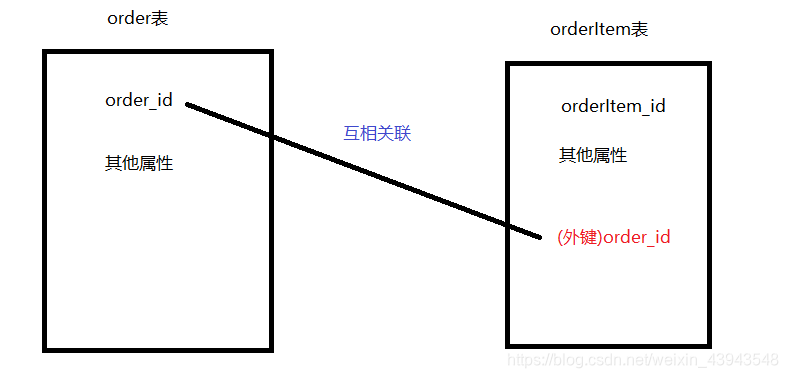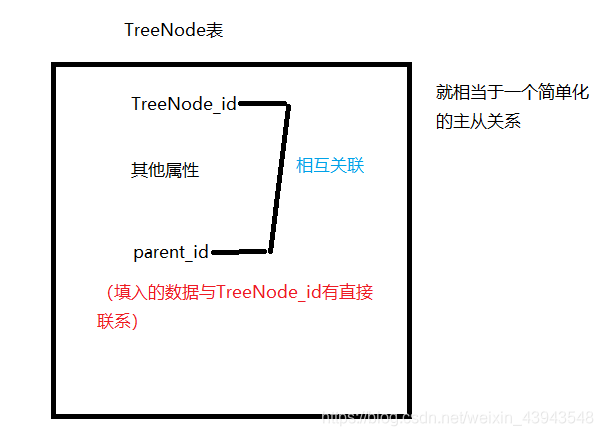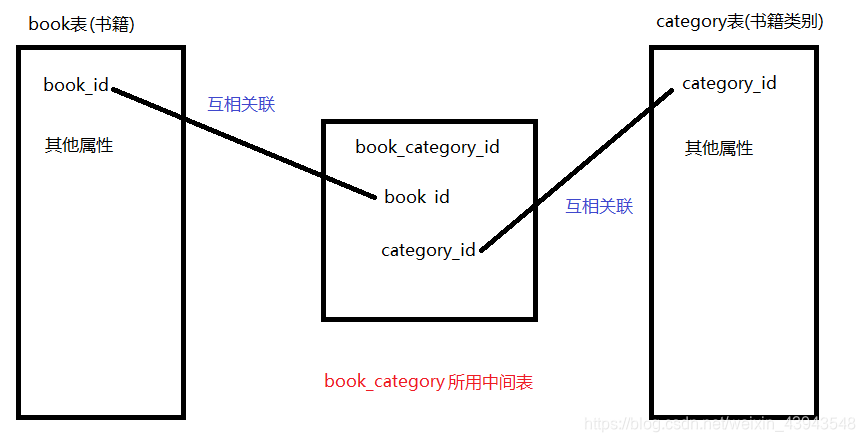前言
这次的关联关系是面对于其他形式的需要,
因为不好理解所以就把所讲的关联关系用图显现出来吧
第一种:一对多

接下来就是我们本章内容所要讲到的,就相当于一个补充。
第二种:一对多(自关联)

第二种:多对多

这就是这俩次的总内容,关联关系因为有许多种类型,所以才会有三种,
可是其实重要的还是配置文件的运用
其他的就是用来测试的
一对多(自关联)
因为自关联的类型可能有很多种,可万变不离其宗,
所以今天就准备用的是权限菜单中的表TreeNode

在这张表里就有我们所需要的东西
额, 就是用来测试用的啦。
所以我们用TreeNode来展示自关联。
首先因为只有一张表,这也代表着只有一个实体类,一个实体配置文件
TreeNode.java
package com.liwangwangFour.entity;
import java.util.HashSet;
import java.util.Set;
public class TreeNode {
private Integer nodeId;
private String nodeName;
private Integer treeNodeType;
private Integer position;
private String url;
private TreeNode parent;
private Set<TreeNode> children = new HashSet<TreeNode>();
private Integer initChildren = 0;
public Integer getNodeId() {
return nodeId;
}
public void setNodeId(Integer nodeId) {
this.nodeId = nodeId;
}
public String getNodeName() {
return nodeName;
}
public void setNodeName(String nodeName) {
this.nodeName = nodeName;
}
public Integer getTreeNodeType() {
return treeNodeType;
}
public void setTreeNodeType(Integer treeNodeType) {
this.treeNodeType = treeNodeType;
}
public Integer getPosition() {
return position;
}
public void setPosition(Integer position) {
this.position = position;
}
public String getUrl() {
return url;
}
public void setUrl(String url) {
this.url = url;
}
public TreeNode getParent() {
return parent;
}
public void setParent(TreeNode parent) {
this.parent = parent;
}
public Set<TreeNode> getChildren() {
return children;
}
public void setChildren(Set<TreeNode> children) {
this.children = children;
}
public Integer getInitChildren() {
return initChildren;
}
public void setInitChildren(Integer initChildren) {
this.initChildren = initChildren;
}
@Override
public String toString() {
return "TreeNode [nodeId=" + nodeId + ", nodeName=" + nodeName + ", treeNodeType=" + treeNodeType
+ ", position=" + position + ", url=" + url + "]";
}
}
配置文件
配置文件可以解决90%的骚操作.
这个配置文件跟之前的没很大的区别,只不过将原本两张表的配置放到了一起。
这个实体类的属性parent对应着TreeNode表上面的parent_node_id
也表示了是多对一个的概念
<many-to-one name="parent" class="com.liwangwangFour.entity.TreeNode"
column="parent_node_id"/>
children属性是一对多的概念,所以用到了《set》或者之前的《pag》
事实上也就是一个的下面有一个大集合。
大集合唯一的共同点就是key
<set name="children" cascade="save-update" inverse="true">
<key column="parent_node_id"></key>
<one-to-many class="com.liwangwangFour.entity.TreeNode"/>
</set>
为了让大家参考,下面就将代码放下
<?xml version="1.0" encoding="UTF-8"?>
<!DOCTYPE hibernate-mapping PUBLIC
"-//Hibernate/Hibernate Mapping DTD 3.0//EN"
"http://www.hibernate.org/dtd/hibernate-mapping-3.0.dtd">
<hibernate-mapping>
<class name="com.liwangwangFour.entity.TreeNode" table="t_hibernate_sys_tree_node">
<id name="nodeId" type="java.lang.Integer" column="tree_node_id">
<generator class="increment" />
</id>
<property name="nodeName" type="java.lang.String" column="tree_node_name">
</property>
<property name="treeNodeType" type="java.lang.Integer" column="tree_node_type">
</property>
<property name="position" type="java.lang.Integer" column="position">
</property>
<property name="url" type="java.lang.String" column="url">
</property>
<many-to-one name="parent" class="com.liwangwangFour.entity.TreeNode" column="parent_node_id"/>
<set name="children" cascade="save-update" inverse="true">
<key column="parent_node_id"></key>
<one-to-many class="com.liwangwangFour.entity.TreeNode"/>
</set>
</class>
</hibernate-mapping>
测试
public class TreeNodeDaoTest {
public TreeNode load(TreeNode treeNode) {
Session session = SessionFactoryUtils.openSession();
Transaction transaction = session.beginTransaction();
TreeNode t = session.load(TreeNode.class, treeNode.getNodeId());
if(t != null && new Integer(1).equals(treeNode.getInitChildren())) {//判断
Hibernate.initialize(t.getChildren());
Hibernate.initialize(t.getParent());
}
transaction.commit();
session.close();
return t;
}
private TreeNodeDao treeNodeDao = new TreeNodeDao();
@Test
public void testLoad() {
TreeNode treeNode = new TreeNode();
treeNode.setNodeId(6);
treeNode.setInitChildren(1);
TreeNode t = this.treeNodeDao.load(treeNode);
System.out.println(t);
System.out.println(t.getParent());
System.out.println(t.getChildren());
}
}
结果

多对多
就看一下实体类的,
因为是多对多,所以有三张表,我们用两个实体类,两个配置文件
book.java

category.java

配置文件
事实上也就是一个的下面有一个大集合。
可是这种的是
两个表之间有一张中间表,这两个表在中间表里都有一个大集合
<set table="t_hibernate_book_category" name="categories" cascade="save-update" inverse="false">
<key column="bid"></key>
<many-to-many column="cid" class="com.liwangwangFour.entity.Book"></many-to-many>
</set>
book.hbm.xml
<?xml version="1.0" encoding="UTF-8"?>
<!DOCTYPE hibernate-mapping PUBLIC
"-//Hibernate/Hibernate Mapping DTD 3.0//EN"
"http://www.hibernate.org/dtd/hibernate-mapping-3.0.dtd">
<hibernate-mapping>
<class name="com.liwangwangFour.entity.Book" table="t_hibernate_book">
<cache usage="read-only" region="com.zking.five.entity.Book"/>
<id name="bookId" type="java.lang.Integer" column="book_id">
<generator class="increment" />
</id>
<property name="bookName" type="java.lang.String" column="book_name">
</property>
<property name="price" type="java.lang.Float" column="price">
</property>
<!--
table : 多对多之间的中间表
name : 书籍类所有的所有类别
inverse : 中间表交于对方维护 false 对方维护,true 自己维护
key : 当前类的主键在中间表里的外建名
many-to-many :
column : 在中间表中key相对应的主键名
class : 对应的表的实体类
-->
<set table="t_hibernate_book_category" name="categories" cascade="save-update" inverse="false">
<!-- one -->
<key column="bid"></key>
<!-- many -->
<many-to-many column="cid" class="com.liwangwangFour.entity.Book"></many-to-many>
</set>
</class>
</hibernate-mapping>
category.hbm.xml
<?xml version="1.0" encoding="UTF-8"?>
<!DOCTYPE hibernate-mapping PUBLIC
"-//Hibernate/Hibernate Mapping DTD 3.0//EN"
"http://www.hibernate.org/dtd/hibernate-mapping-3.0.dtd">
<hibernate-mapping>
<class name="com.liwangwangFour.entity.Category" table="t_hibernate_category">
<id name="categoryId" type="java.lang.Integer" column="category_id">
<generator class="increment" />
</id>
<property name="categoryName" type="java.lang.String" column="category_name">
</property>
<set table="t_hibernate_book_category" name="books" cascade="save-update" inverse="true">
<key column="cid"></key>
<many-to-many column="bid" class="com.liwangwangFour.entity.Category"></many-to-many>
</set>
</class>
</hibernate-mapping>
测试
Book.java
package com.liwangwangFour.dao;
import org.hibernate.Hibernate;
import org.hibernate.Session;
import org.hibernate.Transaction;
import com.liwangwangFour.entity.Book;
import com.liwangwangFour.entity.Category;
import com.liwangwangFour.util.SessionFactoryUtils;
public class BookDao {
public Integer addBook(Book book) {
Session session = SessionFactoryUtils.openSession();
Transaction transaction = session.beginTransaction();
Integer bid = (Integer) session.save(book);
transaction.commit();
session.close();
return bid;
}
public Integer addCategory(Category category) {
Session session = SessionFactoryUtils.openSession();
Transaction transaction = session.beginTransaction();
Integer cid = (Integer) session.save(category);
transaction.commit();
session.close();
return cid;
}
public Category getCategory(Category category) {
Session session = SessionFactoryUtils.openSession();
Transaction transaction = session.beginTransaction();
Category c = session.get(Category.class, category.getCategoryId());
transaction.commit();
session.close();
return c;
}
public Book getBook(Book book) {
Session session = SessionFactoryUtils.openSession();
Transaction transaction = session.beginTransaction();
Book b = session.get(Book.class, book.getBookId());
if (b != null && new Integer(1).equals(book.getInitCategories())) {
Hibernate.initialize(b.getCategories());
}
transaction.commit();
session.close();
return b;
}
public void delBook(Book book) {
Session session = SessionFactoryUtils.openSession();
Transaction transaction = session.beginTransaction();
session.delete(book);
transaction.commit();
session.close();
}
public void delCategory(Category category) {
Session session = SessionFactoryUtils.openSession();
Transaction transaction = session.beginTransaction();
Category c = session.get(Category.class, category.getCategoryId());
if(c!=null) {
for (Book b : c.getBooks()) {
// 通过在被控方通过主控方来解除关联关系,最后被控方再做删除
b.getCategories().remove(c);
}
}
session.delete(c);
transaction.commit();
session.close();
}
}
Test
package com.liwangwangFour.dao;
import org.junit.Test;
import com.liwangwangFour.entity.Book;
import com.liwangwangFour.entity.Category;
public class BookDaoTest {
private BookDao bookDao = new BookDao();
@Test
public void testGetBook() {
Book book = new Book();
book.setBookId(1);
book.setInitCategories(1);
Book b = this.bookDao.getBook(book );
System.out.println(b.getBookName());
System.out.println(b.getCategories());
}
/**
* book.hbm.xml inverse=fasle
* category.hbm.xml inverse=true
* 数据添加正常
* 书籍表、桥接表各新增一条数据
*/
@Test
public void test1() {
Book book = new Book();
book.setBookName("b");
book.setPrice(10f);
Category category = new Category();
category.setCategoryId(5);
// 直接将category对象加入到新建的book中是错误的,因为此时的category是临时态的,hibernate是不会管理的
// book.getCategories().add(category);
Category c = this.bookDao.getCategory(category);
// c.getBooks().add(book);
book.getCategories().add(c);
this.bookDao.addBook(book);
}
/**
* book.hbm.xml inverse=true
* category.hbm.xml inverse=true
* 只增加书籍表数据
* 桥接表不加数据
* 原因:双方都没有去维护关系
*/
@Test
public void test2() {
Book book = new Book();
book.setBookName("c");
book.setPrice(10f);
Category category = new Category();
category.setCategoryId(5);
Category c = this.bookDao.getCategory(category);
book.getCategories().add(c);
this.bookDao.addBook(book);
// c.getBooks().add(book);
}
}
总结
多对多的概念主要还是记住并且能够理解就好了,关联关系的类型有很多种
可以慢慢实验
Thanks♪(・ω・)ノ希望对大家有所帮助
 一对多与多对多关联关系配置
一对多与多对多关联关系配置








 本文详细介绍了在Hibernate框架中实现一对多及多对多关联关系的方法,包括配置文件设置、实体类定义及测试代码示例。
本文详细介绍了在Hibernate框架中实现一对多及多对多关联关系的方法,包括配置文件设置、实体类定义及测试代码示例。

















 被折叠的 条评论
为什么被折叠?
被折叠的 条评论
为什么被折叠?








